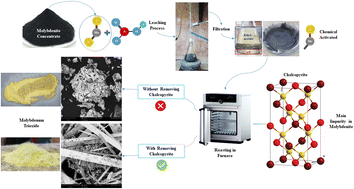Investigation of chalcopyrite removal from low-grade molybdenite using response surface methodology and its effect on molybdenum trioxide morphology by roasting†
Abstract
In this research, purification of molybdenite concentrate (MoS2) using a nitric acid leaching process was employed for the improvement of molybdenum trioxide morphology during oxidative roasting in an air atmosphere. These experiments were performed using 19 trials designed with response surface methodology and three effective parameters being temperature, time, and acid molarity. It was found that the leaching process reduced the chalcopyrite content in the concentrate by more than 95%. The influence of chalcopyrite elimination and roasting temperature on the morphology and fiber growth of the MoO3 was also investigated by SEM images. Copper plays an important role in controlling the morphology of MoO3 and its decrease led to enhancing the length of quasi-rectangular microfibers from less than 30 μm for impure MoO3 up to several centimeters for purified MoO3.



 Please wait while we load your content...
Please wait while we load your content...